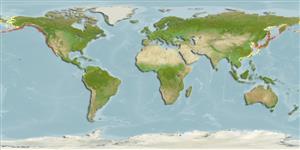Gastropoda |
Nudibranchia |
Discodorididae
Environment: milieu / climate zone / depth range / distribution range
Ecology
Benthic; depth range 0 - 28 m (Ref. 865). Subtropical
Pacific Ocean and the Arctic.
Length at first maturity / Size / Weight / Age
Maturity: Lm ? range ? - ? cm Max length : 8.0 cm TL male/unsexed; (Ref. 822); common length : 5.0 cm TL male/unsexed; (Ref. 312)
It has a firm elongated body that is nearly white with dark brown scattered rings of various sizes.
Assumed maximum length from Ref. 822. Habitat: Occurs in low intertidal to subtidal. Diet: several species of sponges (Ref. 312).
Life cycle and mating behavior
Maturity | Reproduction | Spawning | Eggs | Fecundity | Larvae
Members of the order Nudibranchia are simultaneous hermaphrodites. Mating behavior: Both individuals darts their penis toward each other to induce one to act as a male and the other as the female. The victorious one to penetrate the body wall is the dominant male. Life cycle: Eggs are deposited on a substratum where they develop and hatch into (planktonic) vestigial veliger larval stage and further grow as adults.
Gallivan, G. and J. Danforth 1999 Phylum Mollusca. Marine Science Institute. Http://216.239.51.104/search?q=cache:EEiLeA0OeAMJ:www2.ucsc.edu/simp/guide.pdf+Nuttalina+californica&hl=tl&gl=ph&ct=clnk&cd=8 [accessed 20/01/06] (Ref. 312)
IUCN Red List Status
(Ref. 130435: Version 2025-1)
CITES status (Ref. 108899)
Not Evaluated
Not Evaluated
Threat to humans
Human uses
| FishSource |
Tools
More information
Population dynamicsGrowth
Max. ages / sizes
Length-weight rel.
Length-length rel.
Length-frequencies
Mass conversion
Abundance
Life cycleReproductionMaturityFecunditySpawningEggsEgg developmentLarvae PhysiologyOxygen consumption
Human RelatedStamps, coins, misc.
Internet sources
Estimates based on models
Preferred temperature
(Ref.
115969): 3.9 - 18.3, mean 8.6 (based on 1076 cells).
Fishing Vulnerability
Low vulnerability (10 of 100).
Price category
Unknown.
